![]()


Poppa Neutrino Update and Chronology of Events (to find several other Neutrino posts, use my blog's
search window)
"The road to the mystical is triadic. To get through the doorway is nomadic." (Poppa Neutrino)
David Pearlman borrowed his more colorful name from quantum physics. In his usage, a neutrino is a subatomic particle forever in motion. That certainly applies to Pearlman, aka
Poppa Neutrino, who is 73. He is forever in motion with a new idea, project, or adventure. He and his family, the Neutrinos, have built ten rafts, each almost entirely from salvaged and recycled materials.
With crew, he and his wife sailed from New York across the Atlantic and then back again. They did it on
a raft that they made, in a word, from junk.
National Geographic, The New Yorker and many others have covered his adventures and life. Pearlman has also made a 1800 mile journey down the Mississippi River, from Fridley, Minnesota, past New Orleans, across the Gulf of Mexico to Cuba.
He and his wife,
Captain Betsy, have already left their children with an inheritance. As an example, take the two oldest kids,
Ingrid Lucia and Todd, who took over the
Flying Neutrinos band in 1994 and went on to successful careers as recording and performing artists. (See link at bottom of post)
Open, easy to make friends, the man’s personality was partly revealed when he was asked the name of one raft. He replied that it would be called
Absolute Absolution. When asked why, Neutrino replied, "What I want in my life is total forgiveness, being able to forgive others for whatever it is that they do or have done against me, or anyone else. To be free from the entrapments of anger, holding grudges, living in old vendettas or resentments. Absolute Absolution allows me to live totally in the present moment. I want to learn to give without asking for a reward. To make this kind of a change, I must remind myself daily of what it is I am trying to become. Therefore I have chosen to name the raft
Absolute Absolution."
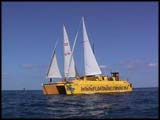
Absolute absolution: there is certainly a spiritual element in his outlook. He speaks of living "totally in the present moment" and being "free from entrapments of anger" and other negative feelings. This can be traced to his background as a student of
Georges Ivanovich Gurdjieff (1872-1949), a Greek-Armenian mystic and self-professed "teacher of dancing" who claimed to teach the truth found in ancient religions such as Islamic Sufism, Zen Buddhism and Hindu Advaita. Gurdjieff's teachings relate to daily self-awareness and our place in the cosmos.
His book is titled Life is Real Only Then, When I Am.
Neutrino has built several rafts, each connected to a different project. The raft
Town Hall has this description: “Built between 1988-90 in Provincetown, MA, from a condemned barge, discarded floating docks, and driftwood from the beach, the
Town Hall was powered by a set of paddlewheels driven by the recycled generator motor from Provincetown's Town Hall, hence the raft's name. It served as the traveling home and stage for the
Flying Neutrinos Family Band, as they traveled from Massachusetts to New York City, arriving in August 1991. Here it remained anchored at Pier 25 in the Hudson River in Manhattan, within sight of the World Trade Towers, the home base for all the Neutrinos. It was also here that the
Son of Town Hall was built, incorporating pieces from the
Town Hall for continuity. After the
Son of Town Halll left New York in 1995, the
Town Hall continued to serve as rehearsal, relaxation and living space for the younger generation of Neutrinos, and other artists and musicians. On May 8, 2000, it was destroyed at the hands of the Hudson River Park Trust.”
Another raft named
Unstoppable Force is described thus: “The Flotsam Follies Variety Show & Floating Stage! The first scrap raft vaudeville stage! Home of the Has Been Circus! A multi-leveled, multi-media Art Machine!" Volunteers are needed to perform on the raft.
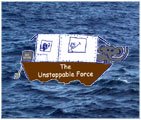
A raft named
June’s Barn: “This idea gradually evolved into the building of a pushboat/floating sawmill/raft as a joint project together with the Dows Historical Society and local volunteers of Dows. Initially this was to be called the
Dows Iowa, but was renamed
June's Barn, in honor of June Hanson, whose barn supplied most of the lumber for the vessel, and to emphasize the recycled nature of the raft.”

As for
The Vilma B, it floated down the Mississippi from Minnesota to Galveston and Arroyo City, Texas. It apparently awaits completion of Neutrino's other projects before its long voyages in its mission as an orphan asylum.

Of
The Vilma B, this was written, she “will be an Orphanage Raft.” The kids will be “street orphans from third world countries such as Brazil, African countries, and India. The children will be those who are living in and surviving on the streets, with literally no one looking out for them or taking responsibility for them. We will get to know them and their situation thoroughly before they ever come to the raft. . . .First let me emphasize that the children we are talking about are children who are living between the cracks of any laws or systems within their country of origin. If this were not the case, if there were any laws or systems covering them, they would not be living in the streets in the first place. So there are no responsible parties in their countries of origin. . . . The children will certainly be better off than they had been before.”
Between voyages, construction, and humanitarian efforts, he seems to enjoy having several irons in the fire, each in a different stage, although I am unsure if completion is his real aim. As in his ocean travels, for him the journey seems more important than the destination.
Here is a chronology, first of his past voyages, then of present and future events. The chronology makes no claim to scholarly thoroughness and documentation. It simply represents my brief attempt to make sense of the many sites about Poppa Neutrino.
14 August 1998. Of Son of Town Hall, The Cape Cod Times reported the raft’s arrival in Europe. “The Floating Neutrinos, Provincetown's unsinkable washashores, tied up in Ireland yesterday after a two-month trip on a raft constructed from plywood, foam and tennis netting.” The account continues: “The Neutrinos, originally a family of street musicians, vowed to cross the Atlantic in their hand-built boat. With the children left safely ashore in the United States, Pearlman, 65, his wife Betsy Terrel, 46, Ed Garry, 37, Roger Doncaster, 44, two Rotweilers and one mutt made the trip. With the Gulf Stream's help they cruised from Newfoundland to Castletownbere, a town on the southern tip of Ireland. The craft arrived yesterday at 6:30 a.m. escorted by the Irish Navy and confronted by hundreds of curious eyes.”
“No one who has seen the boat, Son of Town Hall, could believe it.”
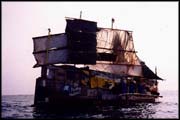 " ‘It looks like a garden shed patched together with nails, knots and rope,’ said freelance journalist Barry Roche after watching Son of Town Hall pull into the small port yesterday.”
" ‘It looks like a garden shed patched together with nails, knots and rope,’ said freelance journalist Barry Roche after watching Son of Town Hall pull into the small port yesterday.”
“Son of Town Hall is a raft made of tree trunks strapped together with planks on top. A rectangular cabin sits on top of the planks. Styrofoam padding surrounds the bottom for stability and buoyancy, said Dwight Raymond, owner of Performance Marine, a boatyard in Kennebunk, Maine. He worked on "The Son" in the winter of 1997, despite the consternation of many yacht owners in Kennebunkport.”
The Times reported that Neutrino took the Rotweilers because he was mad at the way the Cape Cod harbor master treated them. "They deserve to be treated like everyone else," said Neutrino.
"The raft arrived in Provincetown in 1995 powered by a four-horsepower outboard motor, with four family members living inside. There are five children in the family. One night, during a snow storm, it tipped over on its port side, dunking all the Neutrino's possessions and nearly drowning their dogs and cats."
Pearlman’s message to a Provincetown resident: "That you can live your dreams if you have enough determination."
The Times explained that rigged like a Chinese junk, “the vessel's sail was woven on tennis netting the Neutrinos found in New York City and layered like Venetian blinds.”
“The Neutrinos first came to Provincetown as street musicians in 1987. They left after their original houseboat, Town Hall, was condemned by the Board of Heath in 1990. After spending four years on a pier in Manhattan, they returned in 1995. Pearlman kept saying he was heading to Europe. Few believed him.”
An interviewee told the reporter, "I thought they could make it if they were lucky," and "they were."
April 2000. The Vilma B was begun in April of 2000, at the headwaters of the Mississippi River in the Minneapolis area. It made its way down the Mississippi. "Much work still remains ahead before the Vilma B finally becomes a 128’ sea-going vessel, ready to travel the high seas, picking up orphans in Brazil and other Central and South American countries, then on to Africa and India, traveling throughout the world, raising and educating the street orphans along the way."
31 January 2006. Poppa Neutrino teamed with Riley Books to use eBay Auctions to gain sponsors for his raft trip to China. "You Decide Travel Guide," an imprint of Riley Books joined with Pearlman to find sponsors for his China voyage.
The eBay auction offers voyage sponsorships, with sponsors' logos on the boat. The auction is listed as "Sponsor an epic sea voyage of adventure; Poppa Neutrino sails for China on a scrap raft."
In January the raft Island Rooster was tested for final modifications in Baja California, Mexico.. The big leg will be across the Pacific to China. Poppa Neutrino was just south of San Felipe, Baja Mexico, on his raft. It underwent final test floats near Playa Percebu. The Island Rooster was to voyage south through the Sea of Cortez to the tip of Baja California, then into the Pacific for China.
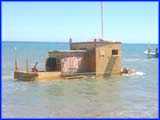 July 2006 A site states about the Island Rooster project that, “the current status of the voyage is unknown but we are looking into it. The Island Rooster is bobbing near the shore in Puertocitos [Baja California, Mexico] which is just over an hour south of San Felipe by car.”
6 July 6 2006. At a site, we encounter a new project of Neutrino, what he has termed the Common Ground Navy. “Common Ground Navy has begun construction of their first raft.” Under way in Red Wing, Minnesota, Poppa Neutrino with two young people, June Kellum and Eric Hyde, was reported as building a raft. They intend to “float the Mississippi and ultimately to send Common Ground Navy rafts all over the globe.” In New Orleans, and probably because of Hurricane Katrina, Neutrino has something called Common Ground Relief in New Orleans. There, he has “an ongoing project to build rafts for hurricane rescue and shelter.”
July 2006 A site states about the Island Rooster project that, “the current status of the voyage is unknown but we are looking into it. The Island Rooster is bobbing near the shore in Puertocitos [Baja California, Mexico] which is just over an hour south of San Felipe by car.”
6 July 6 2006. At a site, we encounter a new project of Neutrino, what he has termed the Common Ground Navy. “Common Ground Navy has begun construction of their first raft.” Under way in Red Wing, Minnesota, Poppa Neutrino with two young people, June Kellum and Eric Hyde, was reported as building a raft. They intend to “float the Mississippi and ultimately to send Common Ground Navy rafts all over the globe.” In New Orleans, and probably because of Hurricane Katrina, Neutrino has something called Common Ground Relief in New Orleans. There, he has “an ongoing project to build rafts for hurricane rescue and shelter.”
Apparently, the Island Rooster voyage won’t start from Mexico, but instead in Minnesota. The voyage may shift to the raft Island Rooster in Mexico, but the voyage, on a different raft, started at the headwaters of the Mississippi. This comment indicates as much. “Poppa Neutrino, founder of Common Ground Navy, is issuing an invitation to come rafting down the Mississippi, across the Gulf of Mexico, through the Panama Canal and across the Pacific to China; or any part of this itinerary.”
There is a Common Ground Air Force, also humanitarian, its purpose is to "bomb" “countries in need with seeds, information, tools, and other useful and helpful items.” Neutrino calls on volunteers “for all aspects of its operation.” It “especially needs donations of equipment and supplies, and computer savvy bloggers and fund raisers.”
As for Neutrino’s work ethic, "We work two hours a day, from 11 a.m. to 1 p.m.," he said. This explanation is provided: “Poppa Neutrino is not into speed. He's into joy and appreciation. He lives for the moment.”
August 2006. This date seems to introduce a report on the Neutrinos from Guatemala on Lago Izabal. (Much geographic distance lies between the various Neutrino projects, which is logistically puzzling .) From the Buoyant Neutrino web site, two raft projects are named as currently underway “in various stages.” One is the sailing a catamaran raft, the Absolute Absolution. There is this comment: “We are again raising funds for the Absolute Absolution project in Europe, but are looking forward to returning to Guatemala in September, when Ed will be supervising the launch of the Absolute Absolution back into the water, and resuming his boat building school.” The school is to help local fisherman. The site refers to a Tom who left Switzerland, “to live an eco-friendly life on Lago Izabal,” and to “our friend Bryan, the Jungle Medic," who "has recently taken delivery of a school bus which has been converted into a mobile clinic, so he will now be able to make more visits to Punta Caimanes and surrounding villages.”
The site names a second project, the Island Rooster, the raft already mentioned, which Poppa Neutrino says is intended for a voyage from Baja California, Mexico to China.
Guatemala, Baja California, Minnesota, New Orleans. Hmmmm. With this division of his humanitarian energies he may not be sailing to China any time soon.
Also August 2006. The Common Ground Navy was reported as under way, headed down the Mississippi. Accompanying the crew was Neutrino’s Boston Terrier, Betty Boop.
"The ramshackle flotilla floated down the Mississippi River to tie up off Winona, Minnesota.
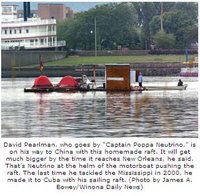
Captained by 73-year-old Poppa Neutrino, the lashed-together navy includes a raft with tents on it, a deck house and three fishing boats, one of which is used to propel and steer the raft.
Neutrino (born David Pearlman), his traveling companion June Kellum and dog Betty Boop arrived Wednesday and plan to stay in Winona for one week.
The raft Neutrino and Kellum built in Red Wing will accumulate donated parts and, by the time it reaches New Orleans, will be able to weather an ocean crossing, he said.
Neutrino, of San Francisco, plans to use his flotilla to visit Cuba again where he has a daughter, then he's off to China.”
13 March 2007. The Happiest Man in the World: An Account of the Life of Poppa Neutrino by Alec Wilkinson. This title will be released on 13 March 2007. ____________________________________________________________
Links.
Random Lunacy
Floating Neutrinos
Poppa Neutrino Speaks
The New Yorker article
Common Ground Navy
The Flying Neutrinos (The children who became musicians)














